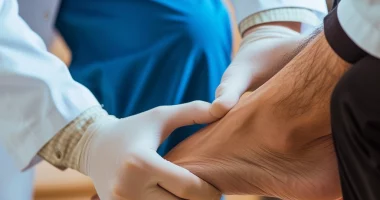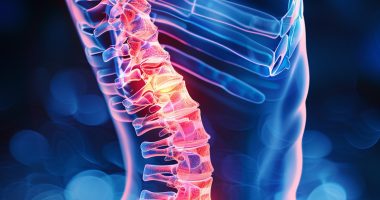Sarcoidosis
What is it?
Sarcoidosis is an autoimmune disease of various body organs and systems, characterized by the formation of inflamed dense nodules – granulomas – in the affected tissues. These neoplasms compress nearby tissues, causing dystrophic changes and sometimes necrosis. In the long-term course of the disease, fibrous connective tissue overgrows, replacing healthy tissue, and the function of the affected organ is irreversibly lost.
About the disease
Sarcoidosis is a relatively rare disease; it affects 2 to 7 people per 100,000 people in Europe. The majority of the patients are aged 20-40 years, primarily women.
In 90% of cases, the pathology affects the lungs and lymph nodes (more often intrathoracic). The skin, eyes, spleen, liver, and bone structures are less frequently affected.
Often, the disease is asymptomatic until a certain point, and it can only be detected by examination. To diagnose sarcoidosis in time, it is recommended to undergo regular preventive examinations and X-rays of the chest organs.
Classification of sarcoidosis
Depending on the localization of the pathological process, sarcoidosis is divided into:
- intrathoracic;
- extrathoracic;
- generalized, affecting several organs at once.
Depending on the changes on the chest radiograph, there are three stages of pulmonary sarcoidosis:
- I – intrathoracic lymph nodes are enlarged;
- II – pathologic process is bilateral, infiltration of lung tissue in combination with lesion of intrathoracic lymph nodes is determined;
- III – expressed fibrosis of lung tissue; intrathoracic lymph nodes are not enlarged; pneumofibrosis gradually expands, and its foci create confluent conglomerates.
Depending on the activity of the pathological process in the course of sarcoidosis, 3 phases are distinguished:
- exacerbations, or active;
- stabilization;
- regression, backward progression, or quiescence of the process.
Symptoms of sarcoidosis
Given the sluggish nature of the course of sarcoidosis, it can often be detected only by radiologic examination, which will show granulomas in the lungs and enlargement of intrathoracic lymph nodes.
The first symptoms of the disease are of a general nonspecific nature:
- a feeling of weakness, fatigue;
- subfebrile body temperature;
- increased size of peripheral lymph nodes;
- joint pain.
These symptoms are a reason to contact a doctor for a complete examination.
As the pathological process develops, the following signs of sarcoidosis appear, depending on the place of its localization:
- In pulmonary sarcoidosis, the patient presents with complaints of cough, recurrent non-intense pain, heaviness in the chest, weakness, decreased appetite and weight, fever, sensation of enlarged lymph nodes, dyspnea, and shortness of breath.
- Symptoms of sarcoidosis of the lymphatic system are the same as when it is localized in the lungs. These two forms of pathology often develop together. When cervical and subclavian lymph nodes are affected, painful induration in their location is determined. With the involvement of abdominal nodes in the pathological process, the patient notes digestive disorders and abdominal pain.
- The leading symptom of nervous system sarcoidosis is Bell’s palsy (uni- or bilateral facial nerve palsy). The disease can affect other nerve centers, impairing the functions of the CNS. If the brain is affected, epileptic activity may develop – the appearance of convulsive seizures.
- In skin sarcoidosis, there are both nonspecific and characteristic symptoms of pathology. The former includes dryness of the skin, its peeling, scarring changes in the skin, violation of its pigmentation, blemishes, weakness, and hair loss. Specific symptoms manifest as small plaques on the skin reddish color, mainly in the upper part of the body, on the face, and the bend of the hands, manifestations of chilled lupus in the form of reddening of the skin and its coarsening (more often on the fingers and the skin of the ears, nose, and cheeks).
- Cardiac sarcoidosis is rare and asymptomatic. However, its prolonged course leads to irreversible changes in the heart, development of heart failure, and arrhythmia. It occurs simultaneously with the lesion of lymph nodes or lungs.
- In ocular sarcoidosis, patients have eyelids affected, decreased vision, foreign body sensation, and non-intense eye pain. During examination, granulomas are often found in the posterior part of the cornea. Sometimes, the disease affects the optic nerve – secondary glaucoma develops.
- In rare sarcoidosis of the ENT organs (ear, nose, pharynx, larynx), the upper respiratory tract’s functions are affected by the manifestations of rhinitis. Granulomas form on the mucosa or cartilage of the sinuses.
- Mild gastric symptoms (gastritis) and less frequent intestinal symptoms (colitis, duodenitis) are more common in gastrointestinal sarcoidosis.
Causes of sarcoidosis
The causes of the development of sarcoidosis are not fully understood. It has been proved that the disease is not infectious.
Provoking factors for sarcoidosis include:
- Intoxication with chemical reagents in people whose occupation involves close interaction with these substances;
- Infection of the body by pathogenic microorganisms: mycobacterium tuberculosis, chlamydia, Epstein-Barr virus and others;
- Prolonged interaction with allergens when the body’s immune defense is compromised.
Diagnosis of sarcoidosis
Diagnosing sarcoidosis begins with an external examination of the patient, questioning him about complaints, and palpation of lymph nodes. Given the rare nature of the disease, sarcoidosis is diagnosed after excluding other pathologies with similar clinical manifestations.
Diagnostic methods for sarcoidosis include:
- Laboratory tests (general and biochemical blood tests).
- Hardware examinations (for visual detection of granulomas and assessment of changes in internal organs are performed: X-ray, computed tomography, MRI, ultrasound, and radionuclide scanning. Different methods of instrumental diagnostics can be used to identify different forms of pathology: eye fundus examination, fibrogastroduodenoscopy (FGDS), echocardiography, ECG, MRI of the brain, bronchoscopy, and so on.
To clarify the diagnosis, histologic examination is performed after biopsy of granulomas, and also mediastinoscopy if indicated.
Treatment of sarcoidosis
Therapy in sarcoidosis aims to reduce the inflammatory process’s activity, preventing the disease’s progression and the overgrowth of fibrous connective tissue.
Patients are prescribed:
- prolonged courses of glucocorticosteroids;
- inhalation of hormones;
- drugs of other groups when the use of corticosteroids is not possible;
- nonsteroid anti-inflammatory drugs (at the initial stage of the disease or when hormone doses are reduced);
- topical agents for relief of skin sarcoidosis.
All these treatment and diagnostic procedures are available in more than 530 hospitals worldwide (https://doctor.global/results/diseases/sarcoidosis). For example, mediastinoscopy can be performed in 27 clinics across Turkey for an approximate price of $5.9 K (https://doctor.global/results/asia/turkey/all-cities/all-specializations/procedures/mediastinoscopy).
Prevention of sarcoidosis
You can reduce the risk of developing sarcoidosis and prevent exacerbations of this disease by following preventive measures:
- lead a healthy lifestyle, give up bad habits (in particular, smoking), which can lead to breathing difficulties;
- avoid prolonged contact with toxic substances that can affect the respiratory tract;
- reduce the amount of time spent in active sunlight.
Rehabilitation
Persons suffering from pulmonary sarcoidosis need dispensary observation with a general practitioner or pulmonologist if the pathological process is localized in other organs – with doctors of the appropriate specialization. Duration of observation in a favorable course of the disease – 2 years, with moderately severe – 3-5 years, with severe – depending on the clinical situation. In a third of patients, the pathology goes into spontaneous remission.



